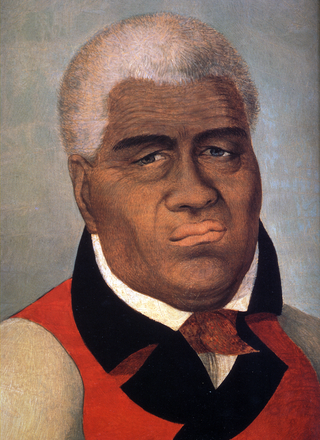
Kamehameha I, also known as Kamehameha the Great, was the conqueror and first ruler of the Kingdom of Hawaii. The state of Hawaii gave a statue of him to the National Statuary Hall Collection in Washington, D.C. as one of two statues it is entitled to install there.

Liliʻuokalani was the only queen regnant and the last sovereign monarch of the Hawaiian Kingdom, ruling from January 29, 1891, until the overthrow of the Hawaiian Kingdom on January 17, 1893. The composer of "Aloha ʻOe" and numerous other works, she wrote her autobiography Hawaiʻi's Story by Hawaiʻi's Queen during her imprisonment following the overthrow.
The history of Hawaii describes the era of human settlements in the Hawaiian Islands. The islands were first settled by Polynesians sometime between 124 and 1120 AD. Hawaiian civilization was isolated from the rest of the world for at least 500 years.

Kamehameha II was the second king of the Kingdom of Hawaii. His birth name was Liholiho and full name was Kalaninui kua Liholiho i ke kapu ʻIolani. It was lengthened to Kalani Kaleiʻaimoku o Kaiwikapu o Laʻamea i Kauikawekiu Ahilapalapa Kealiʻi Kauinamoku o Kahekili Kalaninui i Mamao ʻIolani i Ka Liholiho when he took the throne.

Lunalilo was the sixth monarch of the Kingdom of Hawaii from his election on January 8, 1873, until his death a year later.
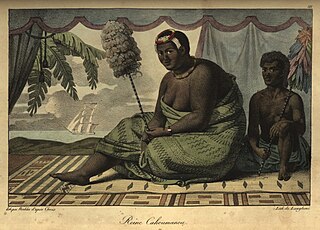
Kaʻahumanu was queen consort and acted as regent of the Kingdom of Hawaiʻi as Kuhina Nui. She was the favorite wife of King Kamehameha I and also the most politically powerful, and continued to wield considerable power as co-ruler in the kingdom during reigns of his first two successors.

John Owen Dominis was prince consort of the Kingdom of Hawaiʻi as the husband of Queen Liliʻuokalani from January 29, 1891, until his death that year.

Washington Place is a Greek Revival palace in the Hawaii Capital Historic District in Honolulu, Hawaiʻi. It was where Queen Liliʻuokalani was arrested during the overthrow of the Hawaiian Kingdom. Later it became the official residence of the governor of Hawaiʻi. In 2007, it was designated as a National Historic Landmark. The current governor's residence was built in 2008 behind the historic residence, and is located on the same grounds as Washington Place.

Ruth Ke‘elikōlani, or sometimes written as Luka Ke‘elikōlani, also known as Ruth Ke‘elikōlani Keanolani Kanāhoahoa or Ruth Keanolani Kanāhoahoa Ke‘elikōlani, was a formal member of the House of Kamehameha, Governor of the Island of Hawaiʻi and for a period, the largest and wealthiest landowner in the Hawaiian islands. Keʻelikōlani's genealogy is controversial. Her mother's identity has never been in question but her grandfather Pauli Kaōleiokū's relationship to Kamehameha I is heavily disputed. While her father has been legally identified as early as 1864, disputes to that lineage continued as late as 1919. As one of the primary heirs to the Kamehameha family, Ruth became landholder of much of what would become the Bernice Pauahi Bishop Estate, funding the Kamehameha Schools.

The Kaʻahumanu Society is a civic club in Hawaii formed by Princess Victoria Kamāmalu in 1864 for the relief of the elderly and the ill. The club celebrates the life of Queen Kaʻahumanu and the preservation of Hawaiian culture.

Kalanikauikaʻalaneo Kai Keōpūolani-Ahu-i-Kekai-Makuahine-a-Kama-Kalani-Kau-i-Kealaneo (1778–1823) was a queen consort of Hawaiʻi and the highest ranking wife of King Kamehameha I.

Victoria Kamāmalu Kaʻahumanu IV was Kuhina Nui of Hawaii and its crown princess. Named Wikolia Kamehamalu Keawenui Kaʻahumanu-a-Kekūanaōʻa and also named Kalehelani Kiheahealani, she was mainly referred to as Victoria Kamāmalu or Kaʻahumanu IV, when addressing her as the Kuhina Nui. In her role of Kuhina Nui, she acted as Regent between the death of the King in 1863 until the election of a new King the same year.

Miriam Auhea Kalani Kui Kawakiu o Kekāuluohi Kealiʻiuhiwaihanau o Kalani Makahonua Ahilapalapa Kai Wikapu o Kaleilei a Kalakua also known as Kaʻahumanu III, was Kuhina Nui of the Kingdom of Hawaii, a queen consort of both Kamehameha I and Kamehameha II, and mother of Lunalilo. In ʻŌlelo Hawaiʻi, Kekāuluohi means; "the vigorously growing vine". She adopted her secondary name Auhea, meaning Where, oh where, in memory of the death of Kamehameha I.
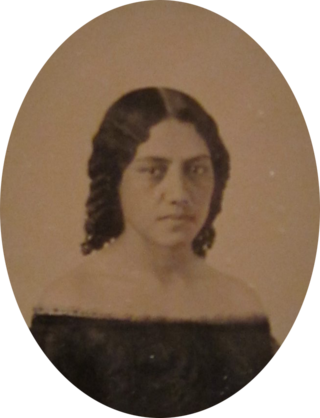
Elizabeth Kekaʻaniau Laʻanui Pratt, full name Elizabeth Kekaʻaniauokalani Kalaninuiohilaukapu Kekaikuihala Laʻanui Pratt, was a Hawaiian high chiefess (aliʻi) and great-grandniece of Kamehameha I, being a great-granddaughter of Kalokuokamaile, the older brother of Kamehameha I, founder of the Kingdom of Hawaii. She was the daughter of Gideon Peleʻioholani Laʻanui and Theresa Owana Kaheiheimalie Rives.
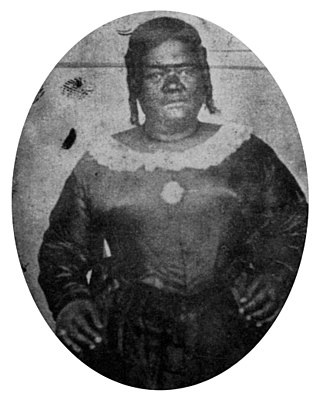
Keahikuni Kekauʻōnohi was a Hawaiian high chiefess who was a member of the House of Kamehameha. She was granddaughter to King Kamehameha I and one of the wives of Kamehameha II. Her Christian name is disputed; it is given as Mikahela in the 1848 Mahele Book and as Miriam in later sources.

The Hawaiian Kingdom, or Kingdom of Hawaiʻi, was a sovereign state located in the Hawaiian Islands. The country was formed in 1795, when the warrior chief Kamehameha the Great, of the independent island of Hawaiʻi, conquered the independent islands of Oʻahu, Maui, Molokai and Lānaʻi and unified them under one government. In 1810, the whole Hawaiian archipelago became unified when Kauaʻi and Niʻihau joined the Hawaiian Kingdom voluntarily. Two major dynastic families ruled the kingdom: the House of Kamehameha and the House of Kalākaua.

Peleuli, formally Peleuli-i-Kekela-o-kalani, was a Queen consort of the Kingdom of Hawaii as a wife of king Kamehameha I.
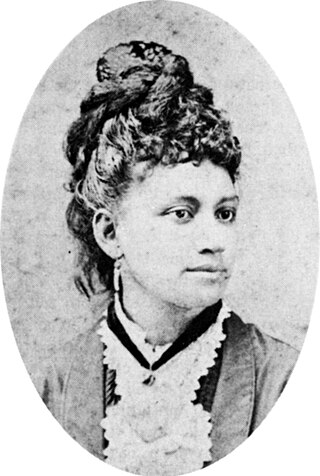
Elizabeth Sumner Chapman Achuck Lapana Keawepoʻoole was a Hawaiian high chiefess during the Hawaiian Kingdom and lady-in-waiting of Princess Likelike. An accomplished Hawaiian composer, she composed the popular Hawaiian love song Sanoe with Queen Liliʻuokalani, which was about a love affair in the Hawaiian royal court in the 1870s.
Mary Lambert Jones Dominis was an American settler of Hawaii and the first mistress of Washington Place in Honolulu. Born into a large New England family, she married merchant sea Captain John Dominis, for whom Honolulu was a frequent port of trade. The couple relocated in 1837 to the Hawaiian Kingdom with their son John Owen Dominis. Their two daughters remained behind to complete their education.






















